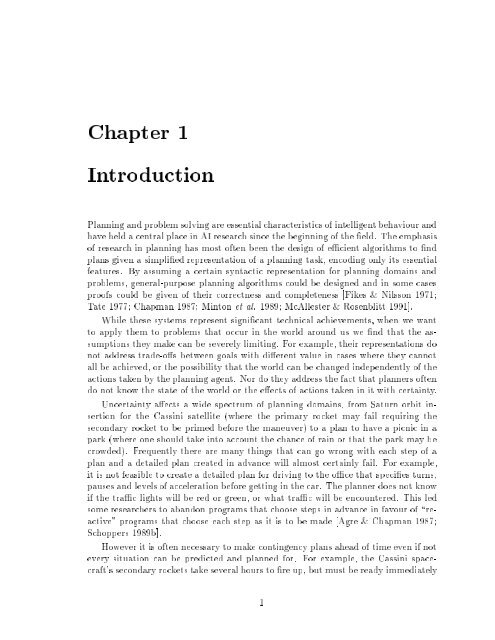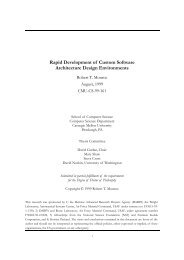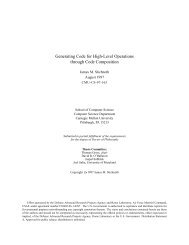Planning under Uncertainty in Dynamic Domains - Carnegie Mellon ...
Planning under Uncertainty in Dynamic Domains - Carnegie Mellon ...
Planning under Uncertainty in Dynamic Domains - Carnegie Mellon ...
Create successful ePaper yourself
Turn your PDF publications into a flip-book with our unique Google optimized e-Paper software.
Chapter 1Introduction<strong>Plann<strong>in</strong>g</strong> and problem solv<strong>in</strong>g are essential characteristics of <strong>in</strong>telligent behaviour andhave held a central place <strong>in</strong> AI research s<strong>in</strong>ce the beg<strong>in</strong>n<strong>in</strong>g of the eld. The emphasisof research <strong>in</strong> plann<strong>in</strong>g has most often been the design of ecient algorithms to ndplans given a simplied representation of a plann<strong>in</strong>g task, encod<strong>in</strong>g only its essentialfeatures. By assum<strong>in</strong>g a certa<strong>in</strong> syntactic representation for plann<strong>in</strong>g doma<strong>in</strong>s andproblems, general-purpose plann<strong>in</strong>g algorithms could be designed and <strong>in</strong> some casesproofs could be given of their correctness and completeness [Fikes & Nilsson 1971;Tate 1977; Chapman 1987; M<strong>in</strong>ton et al. 1989; McAllester & Rosenblitt 1991].While these systems represent signicant technical achievements, when we wantto apply them to problems that occur <strong>in</strong> the world around us we nd that the assumptionsthey make can be severely limit<strong>in</strong>g. For example, their representations donot address trade-os between goals with dierent value <strong>in</strong> cases where they cannotall be achieved, or the possibility that the world can be changed <strong>in</strong>dependently of theactions taken by the plann<strong>in</strong>g agent. Nor do they address the fact that planners oftendo not know the state of the world or the eects of actions taken <strong>in</strong> it with certa<strong>in</strong>ty.<strong>Uncerta<strong>in</strong>ty</strong> aects a wide spectrum of plann<strong>in</strong>g doma<strong>in</strong>s, from Saturn orbit <strong>in</strong>sertionfor the Cass<strong>in</strong>i satellite (where the primary rocket may fail requir<strong>in</strong>g thesecondary rocket to be primed before the maneuver) to a plan to have a picnic <strong>in</strong> apark (where one should take <strong>in</strong>to account the chance of ra<strong>in</strong> or that the park may becrowded). Frequently there are many th<strong>in</strong>gs that can go wrong with each step of aplan and a detailed plan created <strong>in</strong> advance will almost certa<strong>in</strong>ly fail. For example,it is not feasible to create a detailed plan for driv<strong>in</strong>g to the oce that species turns,pauses and levels of acceleration before gett<strong>in</strong>g <strong>in</strong> the car. The planner does not knowif the trac lights will be red or green, or what trac will be encountered. This ledsome researchers to abandon programs that choose steps <strong>in</strong> advance <strong>in</strong> favour of \reactive"programs that choose each step as it is to be made [Agre & Chapman 1987;Schoppers 1989b].However it is often necessary to make cont<strong>in</strong>gency plans ahead of time even if notevery situation can be predicted and planned for. For example, the Cass<strong>in</strong>i spacecraft'ssecondary rockets take several hours to re up, but must be ready immediately1







